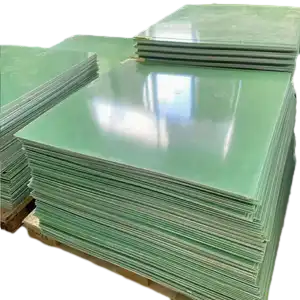Understanding FR4 Sheets and Their Thermal Properties
Composition and Structure of FR4 Sheets
FR4 sheets, widely used in the electronics industry, are composed of a glass-reinforced epoxy laminate material. The "FR" in FR4 stands for "Flame Retardant," indicating its resistance to combustion. These sheets are fabricated by impregnating woven fiberglass cloth with epoxy resin, creating a robust and versatile substrate. The resulting composite material boasts excellent electrical insulation properties, mechanical strength, and dimensional stability, making it an ideal choice for printed circuit boards (PCBs) and various electronic applications.
Thermal Conductivity of FR4 Materials
The thermal conductivity of FR4 sheets is a critical factor in their thermal management performance. Typically, FR4 materials exhibit relatively low thermal conductivity, ranging from 0.25 to 0.5 W/mK. This characteristic can pose challenges in heat dissipation, especially in high-power electronic devices. Understanding the thermal conductivity of FR4 sheets is essential for designing effective thermal management solutions and optimizing overall system performance.
Factors Affecting Thermal Performance
Several factors influence the thermal performance of FR4 sheets. These include the thickness of the material, the copper layer configuration, the presence of thermal vias, and the overall PCB design. Additionally, environmental conditions, such as ambient temperature and airflow, can significantly impact the thermal behavior of FR4-based systems. By considering these factors and implementing appropriate strategies, engineers can enhance the thermal management capabilities of FR4 sheets and improve the reliability of electronic devices.
Techniques for Enhancing Thermal Management in FR4 Sheets
Implementing Thermal Vias and Copper Planes
One effective technique for improving the thermal management of FR4 sheets is the implementation of thermal vias and copper planes. Thermal vias are small, plated holes that create a conductive path between different layers of the PCB, facilitating heat transfer. By strategically placing these vias near heat-generating components, designers can efficiently channel heat away from critical areas. Copper planes, on the other hand, serve as heat spreaders, distributing thermal energy across a larger surface area. Incorporating both thermal vias and copper planes can significantly enhance the overall thermal performance of FR4-based designs.
Optimizing PCB Layout for Heat Dissipation
Careful consideration of PCB layout is crucial for optimizing heat dissipation in FR4 sheets. This involves strategic placement of components, with high-power devices positioned in areas with better thermal management capabilities. Designers should also consider the use of thermal relief patterns, which balance heat dissipation with solderability. Additionally, implementing wider traces for power and ground connections can improve current-carrying capacity and reduce heat generation. By optimizing the PCB layout, engineers can create more thermally efficient designs that maximize the performance of FR4 sheets.
Utilizing Advanced Cooling Solutions
To further enhance the thermal management of FR4 sheets, advanced cooling solutions can be employed. These may include the use of heat sinks, which increase the surface area for heat dissipation, or active cooling methods such as fans or liquid cooling systems. For particularly demanding applications, designers might consider integrating metal-core PCBs (MCPCBs) or insulated metal substrates (IMS) in combination with FR4 layers. These advanced solutions can significantly improve heat dissipation, allowing for higher power densities and improved reliability in electronic systems utilizing FR4 sheets.
Material Selection and Design Considerations for Optimal Thermal Performance
Choosing the Right FR4 Grade for Thermal Applications
Selecting the appropriate FR4 grade is paramount when optimizing thermal management performance. Different grades of FR4 offer varying thermal properties, and choosing the right one can significantly impact the overall thermal behavior of your design. High-performance FR4 materials with enhanced thermal conductivity are available, offering improved heat dissipation capabilities. These specialized grades often incorporate additives or modified resin systems that boost their thermal properties without compromising other essential characteristics. When selecting FR4 sheets for thermal-critical applications, consider factors such as glass transition temperature (Tg), thermal conductivity, and coefficient of thermal expansion (CTE) to ensure optimal performance.
Integrating Thermal Management into Early Design Stages
To achieve optimal thermal performance with FR4 sheets, it's crucial to integrate thermal management considerations into the early stages of the design process. This proactive approach allows engineers to address potential thermal issues before they become problematic. Utilize thermal simulation tools to model and analyze heat distribution within your FR4-based design. These simulations can help identify hotspots, optimize component placement, and guide the implementation of thermal management strategies. By incorporating thermal considerations from the outset, designers can create more efficient and reliable systems that fully leverage the capabilities of FR4 sheets.
Balancing Thermal Performance with Other Design Requirements
While optimizing thermal management is essential, it's equally important to balance these considerations with other design requirements. FR4 sheets are chosen for their versatile properties, including electrical performance, mechanical strength, and cost-effectiveness. When implementing thermal optimization strategies, ensure that they don't compromise these other critical aspects of your design. For instance, while increasing copper thickness can improve thermal conductivity, it may also affect impedance control and signal integrity. Strive for a holistic approach that considers all design parameters, creating a well-balanced solution that maximizes the overall performance of your FR4-based system.
Conclusion
Optimizing the thermal management performance of FR4 sheets is a multifaceted process that requires a comprehensive understanding of material properties, design techniques, and advanced cooling solutions. By implementing strategies such as thermal vias, optimized PCB layouts, and carefully selecting FR4 grades, engineers can significantly enhance the thermal capabilities of their designs. Integrating thermal considerations early in the design process and balancing them with other requirements ensures the creation of efficient, reliable electronic systems. As technology continues to advance, the ability to maximize the thermal performance of FR4 sheets will remain crucial in meeting the growing demands of modern electronics.
Contact Us
For more information about our high-quality FR4 sheets and expert guidance on optimizing thermal management in your designs, please don't hesitate to contact us at info@jhd-material.com. Our team of experienced professionals is ready to assist you in achieving optimal thermal performance for your electronic applications.






